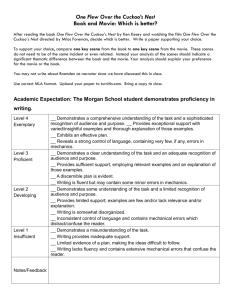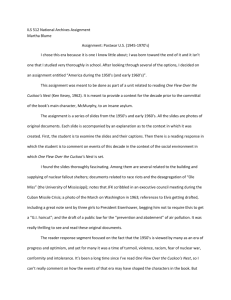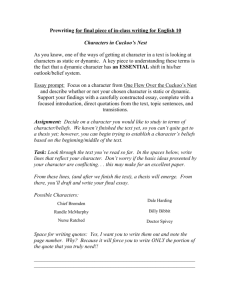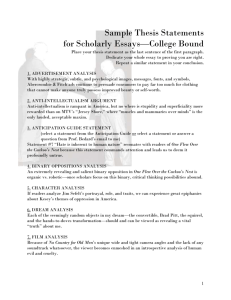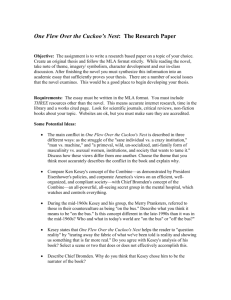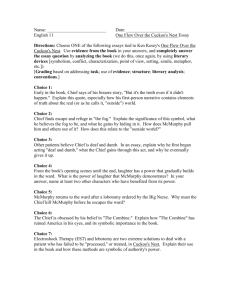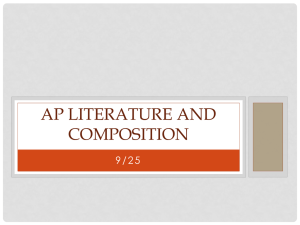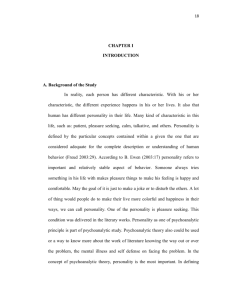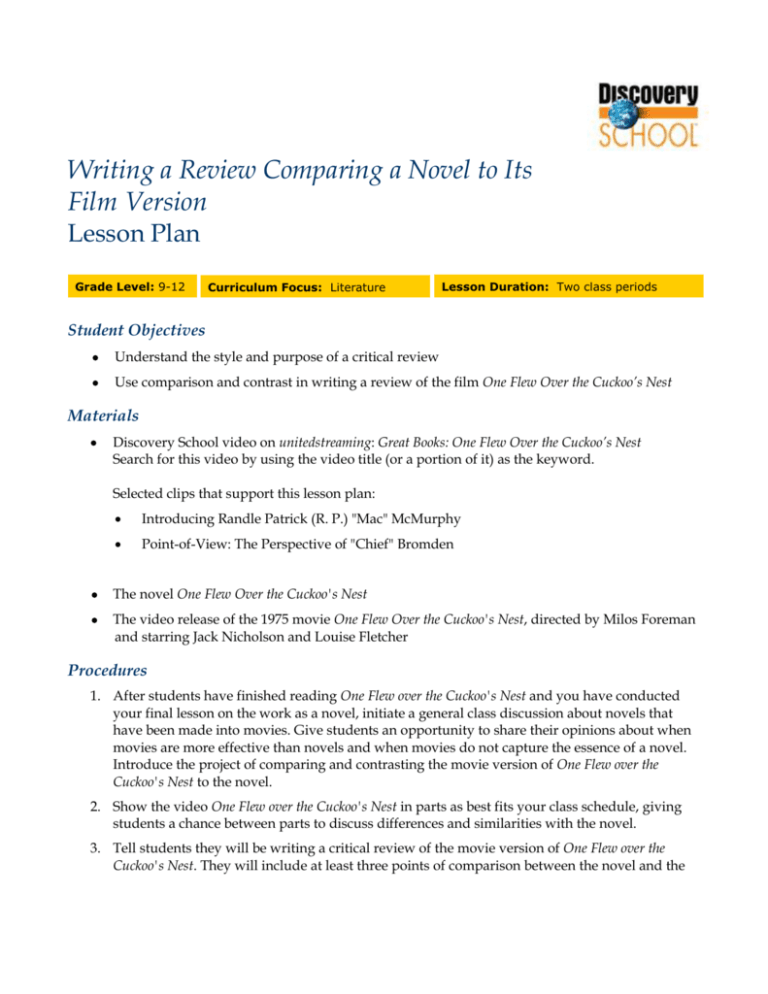
Writing a Review Comparing a Novel to Its
Film Version
Lesson Plan
Grade Level: 9-12
Curriculum Focus: Literature
Lesson Duration: Two class periods
Student Objectives
Understand the style and purpose of a critical review
Use comparison and contrast in writing a review of the film One Flew Over the Cuckoo’s Nest
Materials
Discovery School video on unitedstreaming: Great Books: One Flew Over the Cuckoo’s Nest
Search for this video by using the video title (or a portion of it) as the keyword.
Selected clips that support this lesson plan:
Introducing Randle Patrick (R. P.) "Mac" McMurphy
Point-of-View: The Perspective of "Chief" Bromden
The novel One Flew Over the Cuckoo's Nest
The video release of the 1975 movie One Flew Over the Cuckoo's Nest, directed by Milos Foreman
and starring Jack Nicholson and Louise Fletcher
Procedures
1. After students have finished reading One Flew over the Cuckoo's Nest and you have conducted
your final lesson on the work as a novel, initiate a general class discussion about novels that
have been made into movies. Give students an opportunity to share their opinions about when
movies are more effective than novels and when movies do not capture the essence of a novel.
Introduce the project of comparing and contrasting the movie version of One Flew over the
Cuckoo's Nest to the novel.
2. Show the video One Flew over the Cuckoo's Nest in parts as best fits your class schedule, giving
students a chance between parts to discuss differences and similarities with the novel.
3. Tell students they will be writing a critical review of the movie version of One Flew over the
Cuckoo's Nest. They will include at least three points of comparison between the novel and the
Writing a Review Comparing a Novel to Its Film Version
Lesson Plan
2
film, and comparisons of two characters from the book with the way the actors portrayed them
in the film –McMurphy and one or two others.
4. As a class, discuss the genre of review writing. What do critics review? In what venues do
reviews appear?
5. As a class, discuss the stylistic aspects of review writing and what a review includes, such as
A summary or description of the work under review with a general statement of the
reviewer's opinion about the work
An evaluation of specific elements (for a movie, the elements include, among others, plot,
script, acting, directing, camera work, scenery and costumes, and special effects)
A conclusion that recommends whether or not the reader should experience the work of art
Comparison/contrast using the block method, in which the writer gives all the information
about one item (the movie) and then all the information about the other item (the novel)
Comparison/contrast using the alternating method, in which the writer focuses on one
feature—say, humor—of each item before going on to focus on another feature—say,
narrative technique.
Transition terms used in comparison-contrast writing: also, although, however, likewise, on
the contrary, similarly, etc.
6. Encourage students to apply the writing process to their reviews. They will first go through the
prewriting process (perhaps using a chart to collect notes about the movie). Then they will draft
their review (selecting a tone). Finally, they will revise their review (making sure enough details
support each generalization; replacing vague words such as good, poor, weak, and strong).
Discussion Questions
1. Discuss the conflict in the book as represented by McMurphy and Big Nurse. What might these
characters represent? What kind of larger conflicts (“the battle of the sexes,” the rebel vs. “the
establishment,” etc.) do their clashes symbolize?
2. Describe Chief Bromden. Why do you think that Kesey chose him to be the narrator of the
book?
Assessment
Use the following three-point rubric to evaluate students' work during this lesson.
3 points: Student’s review is very well organized and highly coherent; more than enough
examples to support overall opinion of the movie; no errors in grammar, usage, and mechanics.
2 points: Student’s review is well organized and coherent; enough examples to support overall
opinion of the movie; some errors in grammar, usage, and mechanics.
1 point: Student’s review is weakly organized, lacking coherence in parts; not enough examples
to support overall opinion of the movie; many errors in grammar, usage, and mechanics.
Published by Discovery Education. © 2005. All rights reserved.
Writing a Review Comparing a Novel to Its Film Version
Lesson Plan
3
Vocabulary
combine
Definition: A combination especially of business or political interests. Also, a harvesting machine
that heads, threshes, and cleans grain while moving over a field.
Context: In Chief Bromden's mind, the world is run by an all-powerful, all-seeing secret group—
the Combine.
existentialism
Definition: A philosophical movement embracing diverse doctrines but centering on analysis of
individual existence in an unfathomable universe and the plight of the individual who must
assume ultimate responsibility for his acts of free will without any certain knowledge of what is
right or wrong or good or bad.
Context: The Merry Pranksters and the hippies had some ideas of what existentialism was about.
lobotomy
Definition: Surgical severance of nerve fibers connecting the frontal lobes to the thalamus for the
relief of some mental disorders.
Context: Lobotomy was the ultimate horror in Psychiatry. During one procedure common in the
1940s, a long tool, very much like an ice pick, was driven through the top of the eye sockets into
the brain, into the frontal lobes, and then wiggled about to disconnect the cellular wiring.
psychotic
Definition: Affected with a fundamental mental derangement characterized by defective or lost
contact with reality.
Context: Releasing mental patients from hospitals led to the bizarre phenomenon of having the
street full of psychotic, untreated people.
schizophrenia
Definition: A psychotic disorder characterized by loss of contact with the environment, by
noticeable deterioration in the level of functioning in everyday life, and by disintegration of
personality expressed as disorder of feeling, thought (as in hallucinations and delusions), and
conduct.
Context: Both schizophrenia and LSD impair the brain's ability to distinguish whether impulses
are coming from outside—out there in reality—or from inside—from the workings of one's own
mind.
Academic Standards
Mid-continent Research for Education and Learning (McREL)
McREL's Content Knowledge: A Compendium of Standards and Benchmarks for K-12 Education
Published by Discovery Education. © 2005. All rights reserved.
Writing a Review Comparing a Novel to Its Film Version
Lesson Plan
4
addresses 14 content areas. To view the standards and benchmarks, visit
http://www.mcrel.org/compendium/browse.asp.
This lesson plan addresses the following national standards:
Language Arts—Reading: Uses reading skills and strategies to understand and interpret a
variety of literary texts.
Language Arts—Writing: Uses the general skills and strategies of the writing process; uses
the stylistic and rhetorical aspects of writing
Language Arts – Viewing: Uses viewing skills and strategies to understand and interpret
visual media
Behavioral Studies: Understands conflict, cooperation, and interdependence among
individuals, groups, and institutions.
Support Materials
Develop custom worksheets, educational puzzles, online quizzes, and more with the free teaching tools
offered on the Discoveryschool.com Web site. Create and print support materials, or save them to a
Custom Classroom account for future use. To learn more, visit
http://school.discovery.com/teachingtools/teachingtools.html
Published by Discovery Education. © 2005. All rights reserved.


